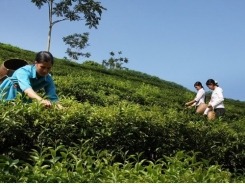Soc Trang is seeking tech support for its agriculture

Situated in the lower section of the Hau River and bordering the East Sea, Soc Trang province features a diversified ecosystem, fertile land, and mild climate, which have proven conducive to agricultural development.
High-quality rice is among the specialities that Soc Trang has become known for
Unique specialities
Soc Trang province is home to some distinctive agricultural products which have built up the Soc Trang “brand” in domestic and export markets, such as the Vinh Chau purple onion, Soc Trang fragrant rice varieties, and the brackish-water shrimp. Agricultural products have generated more than $600 million for Soc Trang in export value each year, accounting for over 95 per cent of the province’s total export value.
Part of the Mekong Delta, Soc Trang has restructured its agricultural infrastructure to push up production, with the value coming out of one hectare now averaging VND141 million ($6,400).
As for the rice crop, cultivated area covered 357,331ha last year, turning out more than two million tonnes of production output annually. The province is focusing on high-quality speciality varieties, particularly proprietary rice breeds, which have seen a continuous increase in growing area.
Last year, speciality rice varieties were grown on 148,463ha, accounting for 41.5 per cent of the province’s total rice areas.
Fruit trees cover nearly 29,000ha in total area, producing more than 198,000 tonnes of fruit per year. Specialised fruit tree areas have gradually taken root in the province, such as green-skinned grapefruits and star apples in Ke Sach district, thick-skinned oranges in My Tu district, custard apples in Nga Nam town, and yellow-flesh longans in Vinh Chau town.
Soc Trang is also home to an esteemed purple onion variety which has grown in the province for generations, mainly in Vinh Chau town, and is now cultivated on over 7,400 hectares, with annual production output touching 138,500 tonnes. These onions are grown following Global GAP standards, and the products have made forays into countries such as Thailand, India, the Philippines, Malaysia, and Indonesia, in addition to serving the domestic market.
Soc Trang is also home to a spacious sugarcane cultivation area, concentrated in Cu Lao Dung and My Tu districts. Last year, the sugarcane area covered 9,547ha, generating 883,040 tonnes of production output.
With its ample riverside areas and 72km coastline, the province has also proven conducive to aquaculture.
Aquaculture areas span over 69,000 hectares, and generated 237,122 tonnes of production output last year. Soc Trang is one of the leaders in terms of industrial-scale shrimp farming area nationwide, with about 111,000 tonnes of output annually.
As for animal husbandry, pigs, cattle, and poultry are the province’s major livestock. By the end of last year, the province was home to 43,633 heads of cattle, including 9,905 dairies, producing 12,235 tonnes of milk per year.
Agri-tech a priority
Like many other localities, Soc Trang has attracted few projects in agricultural production, mainly due to poor infrastructure.
To boost production, according to the Soc Trang Department of Agriculture and Rural Development’s director Luong Minh Quyet, the province spent VND848 billion ($38.5 million) for agricultural infrastructure development from 2014-2016. Most of the sum went to improving infrastructure in aquacultural areas, safe water and environmental hygiene infrastructure in rural areas, and irrigation projects.
The province has also focused on promoting distinctive agricultural products.
To avail of local potential, Soc Trang is calling on domestic and foreign investors to help develop breeds and material sources, as well as the processing and trading of high added-value agro-seafood items. Businesses have been encouraged to develop production in conjunction with product consumption. Developing high-tech agriculture powered by solar energy has been set as a priority.
Soc Trang is said to have among the most sunny hours and highest daily radiation density of any province, qualities which are very favourable for solar energy development.
The combination of solar energy production and agricultural development on the same land area is a common trend worldwide, as it helps investors save money by leveraging a low-cost power source.
Có thể bạn quan tâm
Phần mềm

Phối trộn thức ăn chăn nuôi

Pha dung dịch thủy canh

Định mức cho tôm ăn

Phối trộn phân bón NPK

Xác định tỷ lệ tôm sống

Chuyển đổi đơn vị phân bón

Xác định công suất sục khí

Chuyển đổi đơn vị tôm

Tính diện tích nhà kính

Tính thể tích ao hồ




 Vegetable and fruit export, import turnover rockets up
Vegetable and fruit export, import turnover rockets up  Rice exports up significantly
Rice exports up significantly